What are the properties of metals? many times, we asked this question, as each metal has some physical and chemical properties! In this article, we will learn these all properties in details! let’s explore!
What are the Properties of Metals?
Let’s start with the basics of the properties of metals! In our daily life, we are surrounded by numerous metals and non-metals. From morning to night we use various appliances which are made of specific material. Every material selection has its reasons behind it.
- Why we value gold and silver so much?
- Why iron which is also metal is so cheap?

Iron is used in gardening instruments such as sickles etc. But steel is used to make cars while aluminium is used in aeroplanes.
Physical & Chemical Properties of Metals
Many utensils are made of metals and their handles are made of plastic or rubber.
- The bells in temples are made of metals that make different sounds.
- All metals we see are in solid nature but mercury in the thermometer is liquid in nature.
- All these specific uses are based on specific properties.
- Moving on to the engineering aspect we always prefer steel over iron in construction. Alloys are preferred over metals now.
Why is that? Metals too have their own limitations and they are overcome by specific processes, as different metals have different properties. These properties can be,
- Physical properties
- Chemical Properties
- Mechanical properties
Let’s go through metal’s properties and their limitations to know this answer. Metals go through a long process before we see in their form. Metals are obtained from mines in the form ores. It has lots of impurities which are removed by many processes such as oxidation, reduction, calcination, roasting and smelting. Later metals are refined and brought in the use. Elements are generally classified into 2 groups broadly
- Metals
- Non metals
Here, we will mainly discuss the physical, chemical & mechanical properties of metals.
What are the Physical Properties of Metal?
Physical Properties of Metals
The properties of metals which can be stated by a physical system and it is measurable are known as physical properties of metals. There are a lot of physical properties of metals, as follows
Malleability
- Simply put the ability of a material to beaten into a thin sheet.
- Due to this only thin surfaces are obtained.
- Metals can be rolled.
- Silver foil, Aluminium foil are some examples.
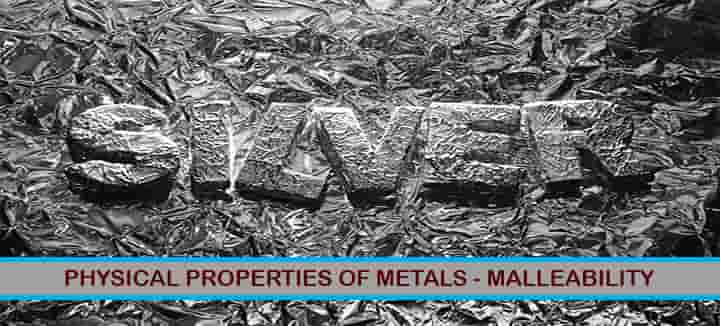
Ductility
- Simply put metal can be drawn into a wire.
- Silver and Gold jewelry is possible due to this reason.
- Copper is used to make power lines.
Sonorous
- Simply put it’s a property that makes a sound after hitting.
- School bells, musical instruments are examples.
Lustre
- The incident light gets reflected by the metals and this is called lustre.
- They have a shining surface. They act as a reflector. Gold, Silver, Platinum are some examples.
Physical state
- Metals are generally are in a solid-state at room temperature.
- The only exception is mercury.
- Some metals are soft in nature so much so that they could be cut by a knife. Ex Sodium, Potassium.
Density
- It is a ratio of mass to volume.
- Generally, all metals are dense in nature.
Conductivity
- Metals have high conductivity electrons travel faster and easily through the metal.
- Metals are excellent conductors as they can conduct both heat and electricity with ease.
Example – we use copper wires because they provide less resistance to the flow of electrons.
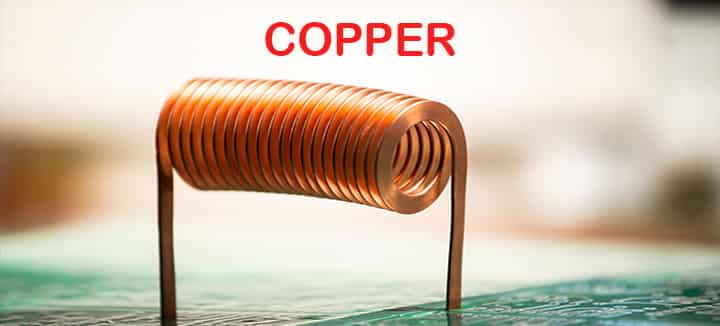
As atoms are closely packed in metals, due to this energy get transferred very fast, as one atom starts vibrating it results into the next one and it goes on. This way metal gets heated due to the process of conduction.
While the atomic structure is such that the valency of them is 1, 2, 3. That means there are these valence electron rotating around nucleus. So it becomes easy to lose such electron to form octet and hence metals are electro positive in nature. These valence electron only make sure the electric current gets travelled. Current is nothing more than a flow of electrons.
What are the Chemical Properties of Metals?
Chemical Properties of Metals
The chemical properties of metals are simply the properties which is related to chemical structure and can be observed by chemical reactions only. Let’s see different chemical properties of metals, as follows
Reaction with Acids
- Metals react with acids to release H2 gas making pop sounds.
Reaction with Base
- Aluminium and Zinc react with common bases.
- Here also metals generally release H2 gas.
Reaction with Water
- Hydroxides get formed when metals react with water.
- These hydroxides are basic in nature.
- Some reactions are very slow in nature like iron with water.
- Some metals react only with hot water. Ex Mg. to form magnesium hydroxide.
- But some metals are very reactive and even cause explosions when they react with water and hence they are stored in kerosene. Ex Sodium
Reaction with Oxygen
- Such reactions are also called Oxidation. Oxides form a protective layer over material which in turn protects them from further oxidation.
- Some reactions are very vigorous. Potassium or sodium catches fire in the open air.
- Metals react with oxygen to form oxides. Generally, these oxides are basic in nature. Ex CaO, MgO.
- While some are amphoteric in nature means they react with both acid and bases. Ex Al2O3, Fe2O3
- Example – rusting of iron is a common example.
Reactivity
In displacement reaction highly reactive metal always displaces less reactive metal in chemical reaction.
Fe (Iron) + CuSO4 (Copper Sulphate) → FeSO4 (Iron Sulphate) + Cu (copper)
Noble metals
Silver and gold are the metals that are at the bottom of the reactivity series. These are unreactive in their nature and hence they do not react with water, acids, and bases.
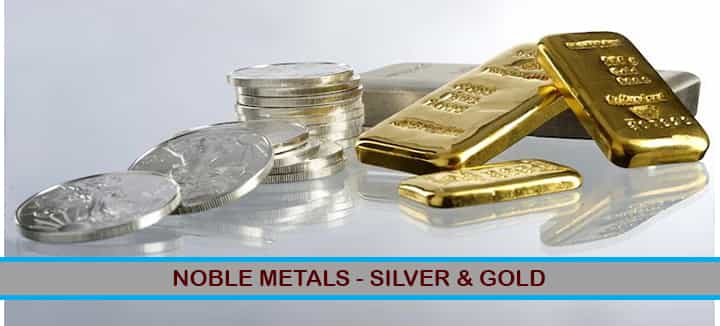
They are chemically neutral. As they occur in Free State in nature. So they are called noble metals.
Metalloids
There are some elements which have properties of both, metals and non-metals are called metalloids. Ex Boron, Silicon, Germanium, Antimony, Arsenic.
Reactivity
Reactivity is decreasing gradually as follows,
- K – Most reactive metal
- Na
- Ca
- Mg
- Al
- Zn (Decreasing Reactivity)
- Fe
- Pb
- H
- Cu
- Hg
- Ag
- Au – Least reactive metal
Mechanical Properties of Metals
As the name suggests, the mechanical properties of metals is defined as the properties which indicate the behavior of metals with respect to the application of external forces. Let’s see a few most important mechanical properties of the metal, as follows:
Strength
- It is the ability of the material by virtue of which it tries to give resistance without going through breakage to externally applied forces which causes stress in the body.
- There are many types of strength as per the application of the force and stresses developed in the material.
- It may be tensile strength, compressive strength, or shear strength.
Elasticity
- It is the ability of the material by which it acquires its original shape after removal of the externally applied force.
- Ex All metals are elastically barring few exceptions.
Plasticity
- It is the ability of the material by which it does not to acquire its original shape after the removal of externally applied force.
- Ex Metal becomes plastic when it has gone through deformation beyond its limit. Its internal atomic structure is permanently displaced.
Stiffness
- It is the ability of the material to give the resistance to externally applied force from getting deformed.
- Ex – All metals go through this deformation. But they are judged on the basis that which material tends to get least deformed.
- This property is measured through the modulus of elasticity.
Resilience
- According to this property, the material absorbs the amount of energy when it is loaded under applied force and releases it when it gets unloaded.
- Ex A material that will absorb more energy within elastic limit without going through any permanent deformation.
- It is measured by the modulus of resilience.
Toughness
- According to this property, the ability of material which tries to absorb energy before the point of time when it gets fractured.
- Basically material goes through bending, twisting, stretching before getting ruptured.
- Ex All components which have to face impact loads should have high toughness.
Malleability
- According to this property, the material can go through a lot of deformation under the application of compressive force without showing cracks. Basically, get beaten into a sheet.
- Ex Metals, steel is rolled into bundles under the application of the rolling process. Rolling, forging, extruding, hammering all these processes are all possible due to this property.
Ductility
- According to this property, the material can go through a lot of deformation under the application of tensile force without showing cracks. Basically, it means to be drawn into a wire.
- Ex Gold, Silver, Copper are generally drawn into wires. All those material which gets deformed into plasticity, still they are drawn into wire till it gets fractured.
Hardness
- It is the ability of the material to resist permanent deformation or penetration.
- Basically, it means material resists cutting, shaping, scratching, and abrasion.
- Example – It is important where there is friction and constant wearing.
Dont be confused between metals and non-metals, both the elements have many difference. Let’s see the difference!
Metals vs Non-Metals
| Parameter | Metals | Non metals |
| Appearance | Lustre | Not shiny |
| Hardness | Hard | Soft |
| Malleable | Beaten into sheet | Can’t |
| Ductile | Drawn in wire | Can’t |
| Heat conduction | Good conduction | Bad conduction |
| Electricity conduction | Good conduction Except mercury which is bad conductor | Bad conduction Except graphite which is good conductor |
| Sonorous | Yes | No |
| Physical state | Generally solid at room temperature, except mercury. | Generally solid and gaseous at room temperature. Except bromine. |
| Melting and Boiling point | Both points are high except gallium and caesium | Both points are except diamond and graphite |
| Periodic table position | At left and centre. S and D block | Right side P block |
| Density | High | Low |
| Agents | Reducing agents | Oxidizing agents |
| Oxides | Basic | Acidic or neutral |
| Electron sharing | Electropositive – they give away electron | Electronegative- They take electron |
Structure of Metals
The metallic structure is generally crystalline in nature. It is a structure in which atoms are placed in repeating or periodic arrays over large distances. The internal structure clearly shows atoms are densely packed and structured in a definite way.
is generally crystalline in nature. It is a structure in which atoms are placed in repeating or periodic arrays over large distances. The internal structure clearly shows atoms are densely packed and structured in a definite way.
As metal is made of just one material so all atomic radii are same in the length. The bonding between them is not directional. As the distance between the nearest atoms is less the energy gets transferred fast and easily. The metal structure is seen in LATTICE, it is a 3-dimensional array of points that coincides with the atom position. Its structure may be hexagonal, tetragonal, cubic, etc.
What are the Main Problems with Metals?
Problems with Metals
Corrosion
- As we know metals go through oxidation and that affects the health of the metal and its life.
- Ex the copper gets greenish color when exposed to air with moisture for a long time.
- This coating is a copper oxide that later turns into copper carbonate.
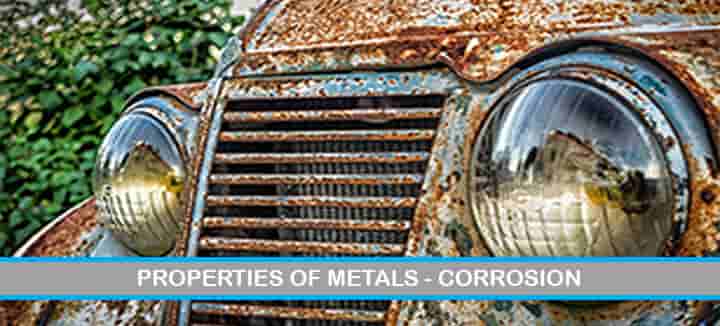
Rusting
- This is the specific term that is used for the oxidation of iron.
- Fe2O3 is the oxide formed over iron which is reddish in color.
- The presence of air and water is a must.
- It affects the iron equipment and hence rusting is avoided by many methods such as painting, alloying, etc.
Solutions for Metals
Painting
- It is one of the most commonly followed practices.
- The iron doors, railings are generally covered by paint.
- That way metal and atmosphere don’t come in contact due to the presence of paint in between them and the properties of metal are preserved from degrading further.
Galvanizing
- The use of zinc metal is done and it is used to give coating over the layer of metal.
- Galvanized sheets are used in making temporary roofs. The most important use is in the shipping industry.
- The hull of a ship is always in water and gets corroded on large scale.
- It affects its life cycle so all ships are compulsorily galvanized at least on the bottom.
- Drums, containers, manhole covers are generally galvanized.
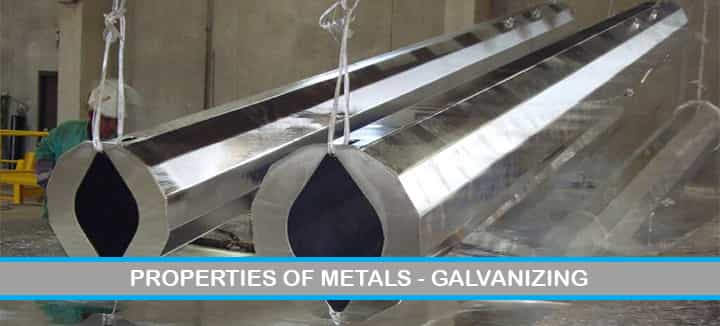
Oiling and greasing
- Oil and grease are applied on constantly rubbed parts to reduce friction.
- This process also helps in case of iron objects to avoid rusting.
Alloying
- Alloy is a homogeneous mixture of two metals or non-metals in a specific proportion, which has very specific properties as per its constituents.
- The alloy has different properties from that of the constituents.
Example – Brass, Bronze, Stainless steel
- Iron utensils will get rusted but the alloy made with nickel and chromium will make it stainless steel. Which will not rust, will have high strength and shining surface.
- Alloys are used for reducing designing constraints. 24-carat gold can’t be used to make jewelry because it will be very weak. Hence copper is alloyed with it to give an attractive and complicated shape as well as strength. Hence we generally see gold is of 22 carats.
- Electroplating
The metals are electroplated with the application of faraday’s law. Two electrodes immersed in an aqueous solution by passing electric current go through the deposition of one metal over another. This creates a layer of less reactive metal over highly reactive metal.
Anodizing
- In this process, a thick oxide layer of Aluminium is formed over a target metal.
- This aluminium oxide coating makes it highly resistant to further corrosion.
- During anodising, a clean aluminium article is made sure to act as an anode and is electrolysed with dilute sulphuric acid.
- The oxygen gas evolved reacts with aluminium to make a thicker protective oxide layer.
General Applications of Metals
- Copper and Aluminium are used in making wires. Due to their electro-positive nature and valency, they are the best candidates for electric circuit wires.
- Zinc is used for galvanising iron material to protect the iron from rusting.
- Jewellery is crafted from silver, gold, and platinum.
- Metals such as iron, copper, and aluminium are utilised to manufacture cooking utensils and industrial equipment.
- Mercury is used in a thermometer as it is highly sensitive to changing temperatures.
- Metals are used to make equipment, measuring instruments and toolkits.
Metal Specific Applications
The vivid applications mainly depend on the core properties of the metals. According to those properties, we are providing the applications of the metals.
Metals with high structural strength: These metals are used for resisting impact damage and carrying large loads. Apart from this, it also has a high resistance to shear, deformation, and torque. However, there are chances that when the load exceeds, these metals can get deformed.
Core strength and resilience: These properties help the metals to be used in bridge construction and high rise building. In addition to heat, strength, and resilience also help in the fabrication of vehicles, appliances, pipes, non-illuminated signs, tools, and railroad tracks.
Good conductor of electricity: The conduction property of metals helps them be used in electrical appliances and for carrying electric current. Electrical grids use them abundantly.
Thermal conductivity: This property makes it quite adequate for the manufacturing of vessels or containers that withstands heating. These are also used for making heat sinks that provide protection-sensitive equipment.
High reflectivity: The metals that are equipped with high reflectivity are mainly used to construct precision astronomical instruments and mirrors. This also helps the metals to be used in the making of metallic jewellery.
Radioactive: There are some of the metals which are equipped with radioactive properties that are being used in nuclear power plants. Here the main usage is for producing energy through nuclear fission.
Shape memory: This is the property that helps in using metals for making pipes, fasteners, and vascular stents. Let’s see a few most widely used metals based on their properties,
- Cast metal – used for the casting process. Ex casting iron.
- Wrought metal – used to rework after casting. Ex pig iron, wrought iron.
- Powdered metal – used in powder metallurgy.
| Metal | Use in alloy |
| Aluminium | Low Weight and high strength and used in aeroplanes. |
| Magnesium | Good strength to weight ratio for missile components. |
| Copper and Beryllium | High strength in spring. |
| Titanium | Ability to resist corrosion. |
| Nickel | Ability to resist corrosion and withstand high temperatures. |
| Tungsten | High stiffness and heat resistance, hence used in tool alloys. |
Conclusion
Hence, we have got a basic idea about the physical and chemical properties of metals. Please feel free to write to us, in case of any doubt!
